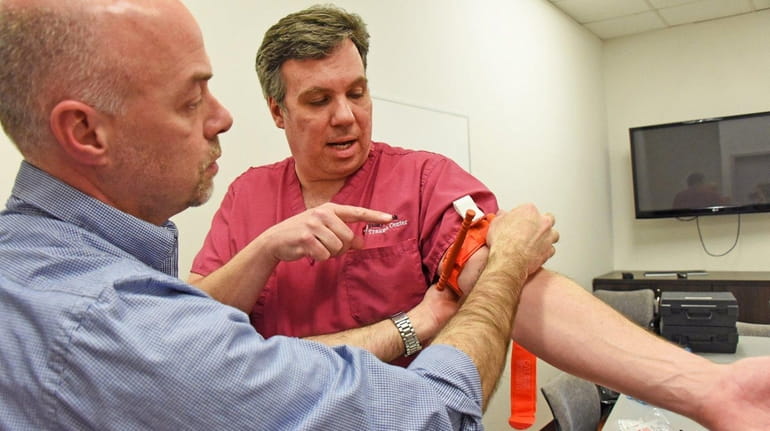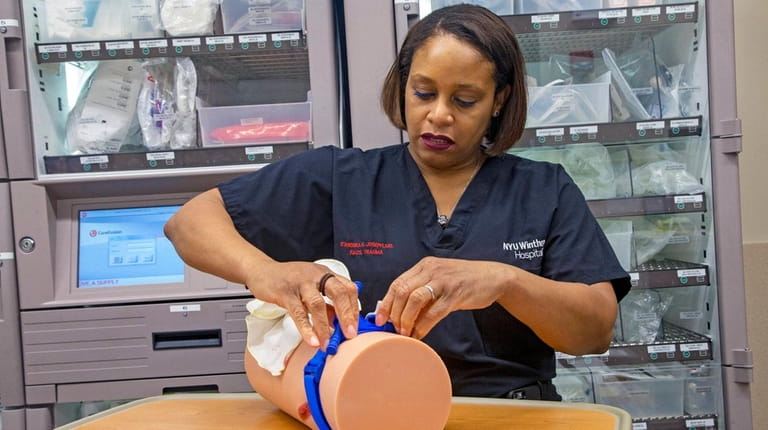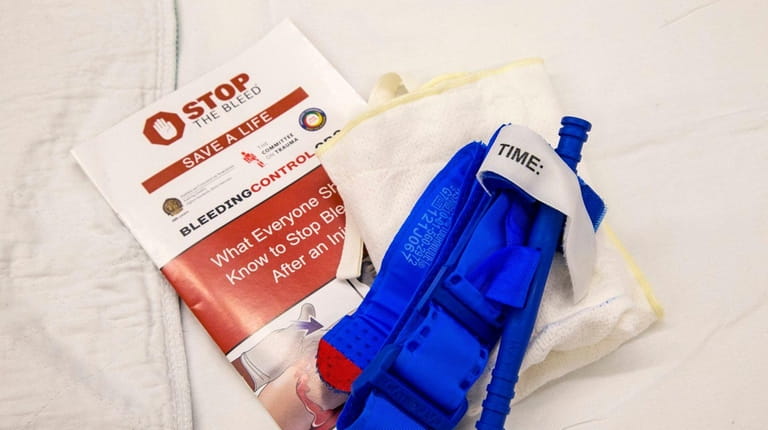‘Stop the Bleed’ training on upswing in LI schools

Dr. James Vosswinkel, medical director of Stony Brook University Hospital's Trauma Department, right, and Colby Rowe, Trauma Center educator and outreach coordinator, demonstrate how to use a tourniquet at the hospital on Thursday, Feb. 15, 2018. Credit: Danielle Finkelstein
Long Island teachers, school administrators and staff are learning to tie tourniquets and dress wounds as part of a federal initiative called “Stop the Bleed” — with about 3,000 people in Suffolk County districts trained in the past 18 months alone.
It is among the newest steps being taken to respond to casualties before first responders arrive at a mass shooting or other emergency situation, such as the massacre at Marjory Stoneman Douglas High School in Parkland, Florida, where a former student opened fire Wednesday, killing 17 people.
“As a father, as a human, as a trauma surgeon, it makes my stomach turn. The fact that I can sit here and rattle off the names of school after school where this has happened, that’s awful,” said Dr. James Vosswinkel, medical director of the Trauma Department at Stony Brook University Hospital. “Ideally, we would love to prevent all of these tragic situations from occurring. Since we can’t prevent them, we are obligated to prepare ourselves for when they do happen.”
The hospital’s medical educators have held group sessions so far in 20 school districts, including Comsewogue, Half Hollow Hills, Hampton Bays, Patchogue-Medford, Shoreham-Wading River, Smithtown, Three Village, West Babylon and William Floyd.
The 90-minute class is free and typically conducted on staff development days or after school.
In the Three Village system, about 500 employees — from teachers to principals to custodians and clerical staff — have been trained and the district has “Stop the Bleed” kits containing tourniquets and gauze placed in locations throughout the schools.
“We want to make sure that every staff member is equipped to handle a situation — a crisis — like we saw in Florida,” said Three Village Superintendent Cheryl Pedisich. “Any school in America is vulnerable.”

Dr. D'Andrea Joseph, chief of trauma at NYU Winthrop Hospital, demonstrates use of a medical kit used in "Stop the Bleed" training on Thursday, Feb. 15, 2018 in Mineola. Credit: Howard Schnapp
The 6,500-student district, like others, fielded several telephone calls Thursday from concerned parents in the aftermath of the Florida school shooting.
The national awareness campaign, initiated by a federal interagency work group and launched in October 2015, aims to provide first responder and military medic training to the general public to save lives.
A coalition of stakeholders led by the American College of Surgeons began pushing for it shortly after the shootings at Sandy Hook Elementary School in Newtown, Connecticut, where a gunman killed 20 students and six teachers on Dec. 14, 2012. More than 10,000 people have been trained nationwide, including members of Congress.
Doctors and nurses say the skills learned are applicable in a variety of situations — school, car crashes and injuries at work or at home, as well as during acts of violence. But fear of a large-scale tragedy prompts the most interest in the training programs, particularly from school districts.

A typical "Stop the Bleed" medical kit, such as this one at NYU Winthrop Hospital in Mineola, includes gauze and a tourniquet to halt excessive bleeding. Credit: Howard Schnapp
“There is never an intent to normalize this. We should in no way be complicit in normalization of this behavior or these events,” said Dr. D’Andrea Joseph, chief of trauma and acute care surgery at NYU Winthrop Hospital in Mineola. “But as physicians, as healers, as people with a goal of survival, we are supportive of citizens learning how to maximize survival in people who are hurt.”
More than 300 people have taken the training course at NYU Winthrop, mostly security officers, firefighters, public safety officers and nurses in an effort to “train the trainers.” On Thursday, a large school district had registered for the course, officials said.
Allison Anderson, a registered nurse at South Nassau Communities Hospital who runs community education programs on trauma prevention, said she taught the course earlier this month to the principal and faculty at Long Beach High School.
In November, she said, when classes were not held because of the Veterans Day observance, she trained 12 school nurses in the Rockville Centre school district. She also has trained public employees in the Village of Rockville Centre, as well as teachers at a nursery school in Merrick, she said.
About 200 South Nassau hospital workers have been trained, and the Oceanside hospital will offer the course to the public on April 4 and April 9.
South Nassau’s one-hour class is about half lecture and half “hands-on” instruction on how to control excessive external bleeding with a tourniquet and pack a wound with gauze. All of the materials are included in kits that Anderson says should be present in all public places where automated external defibrillators, or AEDs, are kept. That includes many schools and libraries.
“We really stress the importance of learning this,” Anderson said. “Just like anyone can learn CPR, anyone can learn how to control life-threatening bleeding.”
Gilgo-related search in Manorville ... UBS Arena MTV Awards ... Jericho fatal crash ... Girls softball league
Gilgo-related search in Manorville ... UBS Arena MTV Awards ... Jericho fatal crash ... Girls softball league

